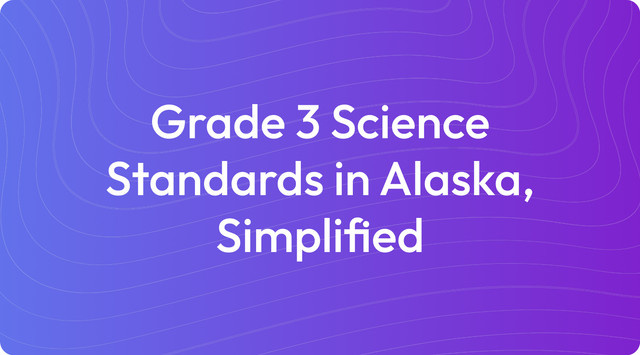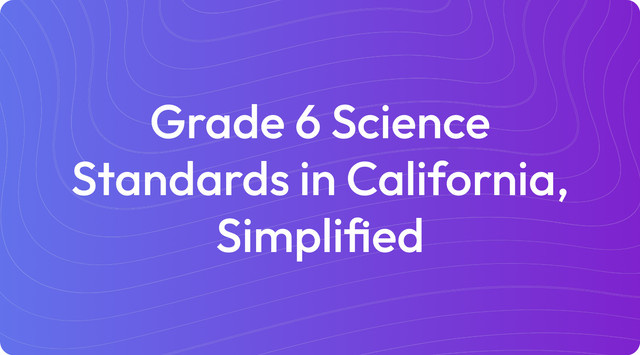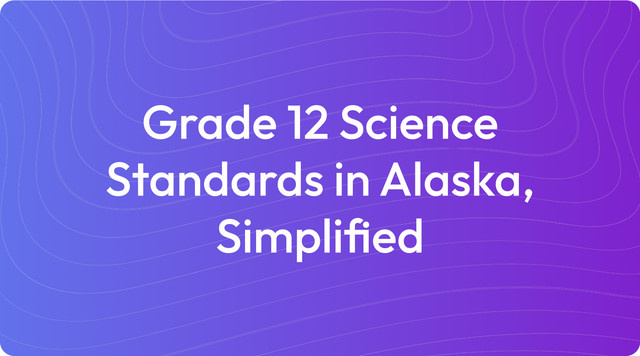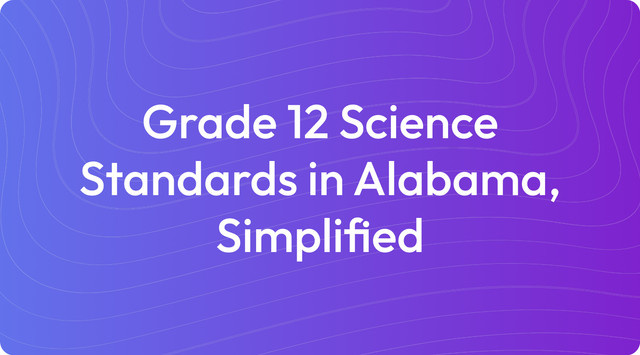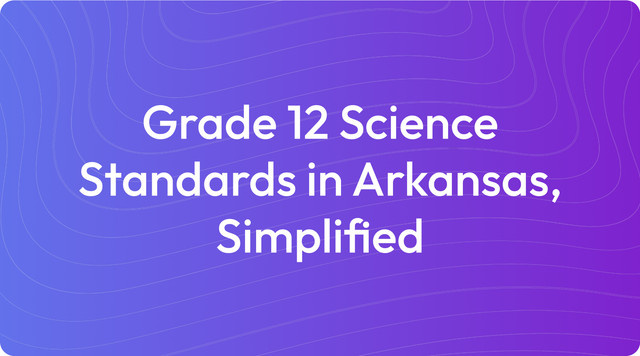Grade 8 Science Standards in Alabama, Simplified
Grade 8 science features chemistry, forces, Earth’s history, and space in Alabama. Get a quick summary—read more on TeachShare!
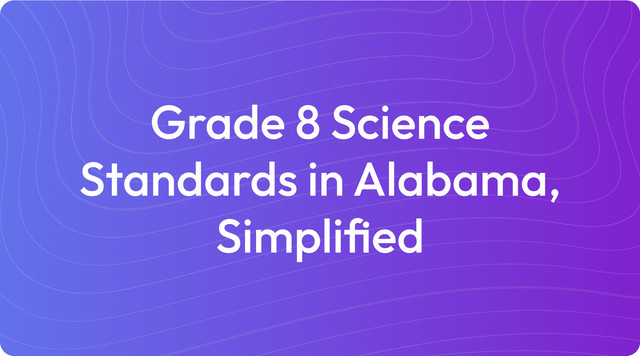
Understanding education standards can feel like a significant task, but it doesn't have to be. At Teachshare, we believe in making these guidelines clear and accessible for you. This helps you focus on what you do best: teaching.
Education standards are a set of learning goals for what students should know by the end of a grade. For teachers, they provide a roadmap for instruction without dictating how you should teach. For example, the Grade 8 Science Standards in Alabama outline key concepts in physical science, giving you a framework for your curriculum.
What Are Grade 8 Science Standards in Alabama?
The Grade 8 Science Standards in Alabama, based on the state's Course of Study, center on Physical Science and Engineering Design. These standards are designed to build a strong foundation for future STEM studies by focusing on hands-on investigation, data analysis, and applying concepts to real-world situations. The standards are organized into the following key areas:
Key Areas of Grade 8 Science Standards in Alabama
- 1. Physical Science (PS): Matter and Energy
- Standard 1: Develop models to describe the atomic composition of simple molecules and extended structures.
- Standard 2: Gather and interpret data on the properties of substances before and after chemical reactions to determine if a chemical reaction has occurred.
- Standard 3: Construct explanations for how energy is transferred and conserved, including thermal, electrical, and mechanical energy.
- 2. Forces and Motion
- Standard 4: Analyze and interpret data to describe the relationship between force, mass, and motion.
- Standard 5: Use mathematical representations to describe the motion of objects (e.g., speed = distance ÷ time).
- Standard 6: Develop and use models to demonstrate Newton’s Laws of Motion.
- 3. Waves and Electromagnetic Radiation
- Standard 7: Use models to describe how waves transfer energy through matter and space.
- Standard 8: Analyze and interpret data to explore the relationship between wave properties (e.g., amplitude, frequency) and energy.
- Standard 9: Develop and use models to describe how light interacts with objects (e.g., reflection, refraction, absorption).
- 4. Engineering, Technology, and Applications of Science (ETS): Problem-Solving
- Standard 10: Apply scientific principles to design, construct, and test devices that solve problems (e.g., energy-efficient systems or vehicles).
Key Learning Goals for Grade 8 Science in Alabama
- 1. Model and Explain: Students use models to explore concepts like atomic structure, energy transfer, and wave behavior.
- 2. Analyze Data: Students collect and interpret data related to motion, forces, and energy conservation.
- 3. Problem-Solving: Students engage in engineering challenges to design solutions for real-world problems.
Source: Alabama State Department of Education, Next Generation Science Standards
Key Tested Standards
The Grade 8 Science Standards in Alabama, based on the Alabama Course of Study: Science (2015), focus on key concepts in Physical Science and Engineering Design. Below are the key tested standards, which assess students' abilities to analyze data, construct models, and solve real-world problems related to matter, energy, forces, and motion.
Key Tested Standards for Grade 8 Science in Alabama
1. Physical Science (PS): Matter and Energy
- Standard 1: Develop models to describe the atomic composition of simple molecules and extended structures.
Why It’s Key: This standard helps students understand the structure of matter and how atoms form molecules, which is foundational for chemistry. - Standard 2: Gather and interpret data on the properties of substances before and after chemical reactions to determine if a chemical reaction has occurred.
Why It’s Key: Students learn to identify chemical changes and explore the conservation of matter during reactions. - Standard 3: Construct explanations for how energy is transferred and conserved in systems, including thermal, electrical, and mechanical energy.
Why It’s Key: Students explore how energy moves through systems and how it powers everyday phenomena.
2. Forces and Motion
- Standard 4: Analyze and interpret data to describe the relationship between force, mass, and motion.
Why It’s Key: This standard introduces Newton's Second Law and helps students understand how forces influence motion. - Standard 5: Use mathematical representations to describe the motion of objects (e.g., speed = distance ÷ time).
Why It’s Key: Students apply math to real-world problems, linking scientific concepts to measurable outcomes. - Standard 6: Develop and use models to demonstrate Newton’s Laws of Motion.
Why It’s Key: This standard helps students understand fundamental physics principles that govern motion.
3. Waves and Electromagnetic Radiation
- Standard 7: Use models to describe how waves transfer energy through matter and space.
Why It’s Key: Students explore the behavior of waves and their role in transferring energy, such as sound or light. - Standard 8: Analyze and interpret data to explore the relationship between wave properties (e.g., amplitude, frequency) and energy.
Why It’s Key: This standard helps students understand the connection between wave characteristics and the amount of energy they carry. - Standard 9: Develop and use models to describe how light interacts with objects (e.g., reflection, refraction, absorption).
Why It’s Key: Students study how light behaves in the real world, laying the foundation for fields like optics and engineering.
4. Engineering, Technology, and Applications of Science (ETS): Problem-Solving
- Standard 10: Apply scientific principles to design, construct, and test devices that solve real-world problems (e.g., energy-efficient systems or vehicles).
Why It’s Key: This standard encourages students to apply knowledge of matter, energy, and forces to create innovative solutions in engineering and technology.
Why These Standards Are Key for Testing:
- Analyze Data: For example, interpreting data on the motion of objects, chemical reactions, or wave properties.
- Develop and Use Models: For example, creating models of molecules, Newton’s Laws, or wave behavior.
- Apply Math and Science: For example, solving problems using equations like speed = distance ÷ time or interpreting graphs of motion and energy transfer.
- Problem-Solve: Designing and testing solutions for real-world challenges, such as creating energy-efficient systems or exploring light behavior.
Source: Alabama State Department of Education, Next Generation Science Standards
Example Learning Objectives for Unit Planning
Learning objectives are clear, specific statements that define what students should be able to do by the end of a lesson or unit. They act as a guide for both you and your students, ensuring instruction is focused and progress can be measured effectively. These objectives break down broader standards into manageable, actionable goals.
To help with your unit planning, here are examples of learning objectives for two Grade 8 Science standards. These are written in student-friendly “I can” statements and align with the Alabama Course of Study: Science (2015):
Standard: Analyze and interpret data to describe the relationship between force, mass, and motion (Standard 4).
- I can explain how force, mass, and motion are related using Newton’s Second Law of Motion (F = ma).
- I can collect and analyze data to see how increasing or decreasing force or mass changes an object's motion.
- I can use graphs or tables to show how force and motion are connected.
- I can describe real-world examples of how force, mass, and motion interact, like pushing a heavy object or accelerating a car.
Standard: Develop and use models to describe how light interacts with objects (e.g., reflection, refraction, absorption) (Standard 9).
- I can explain how light behaves when it hits different objects, like mirrors, lenses, or water.
- I can describe the difference between reflection, refraction, and absorption of light.
- I can create a model or diagram to show how light bends or reflects when passing through different materials.
- I can provide examples of how light interaction is used in real life, like in glasses, telescopes, or cameras.
Key Changes & Updates
The Grade 8 Science Standards, based on the Alabama Course of Study: Science (2015), include updates designed to enhance student engagement and prepare them for advanced STEM studies. These changes emphasize hands-on learning, engineering practices, and scientific inquiry to help you connect concepts to real-world applications. Here are the key updates:
- Emphasis on Hands-On, Inquiry-Based Learning: Students conduct experiments and investigations to explore physical science concepts like forces, motion, and energy.
- Integration of Real-World Applications: Lessons are designed around practical scenarios to help students see the relevance of science, such as exploring how light interacts with objects in cameras or glasses.
- Focus on Data Analysis and Evidence-Based Explanations: Students are encouraged to collect, analyze, and interpret data to identify patterns and make conclusions.
- Engineering Design Integration: Engineering practices are embedded into the curriculum, requiring students to design, test, and refine solutions to real-world problems like creating energy-efficient systems.
- Cross-Disciplinary Connections: The standards promote integrating math skills to calculate motion and energy, as well as literacy skills for writing lab reports and constructing explanations.
- Deeper Exploration of Energy and Motion: Students explore concepts like energy transfer, conservation, and the relationship between force and motion in more detail.
- Expanded Study of Waves and Light: The curriculum includes a more thorough investigation of how waves transfer energy and how light behaves, including reflection, refraction, and absorption.
- Environmental and Technological Problem-Solving: Students apply their knowledge to solve challenges using technology and engineering, such as designing devices to improve renewable energy systems.
Create with TeachShare
We understand that aligning your lessons with state standards while keeping them engaging is a constant challenge. Our goal is to support you in this important work. With our platform, you can quickly generate activities, assessments, and full lesson plans that are directly tied to the Alabama Grade 8 Science Standards. This frees you up to focus on your students and their learning. Start creating standards-aligned instructional resources with TeachShare now.
Frequently Asked Questions
What are the core topics for Grade 8 Science in Alabama?
The curriculum centers on Physical Science and Engineering Design. Here’s a look at the key areas you'll cover:
- Matter and Energy: Exploring the atomic makeup of substances, the conservation of matter in chemical reactions, and how energy is transferred
- Forces and Motion: Investigating the connection between force, mass, and motion, including Newton’s Laws
- Waves and Light: Understanding wave properties, how they transfer energy, and the behavior of light
- Engineering Design: Applying scientific principles to design and test solutions for real-world challenges
How do the current Alabama science standards differ from previous ones?
The Alabama Course of Study: Science (2015) marks a shift towards more dynamic and applied learning. The main points of emphasis are:
- Hands-On Learning: Students are encouraged to actively investigate concepts through experiments
- Real-World Applications: Lessons are designed to connect scientific ideas to everyday situations
- Engineering Integration: Students use science to design, test, and improve solutions to practical problems
- Critical Thinking: The focus is on analyzing data, building models, and forming evidence-based conclusions
Can you give some examples of classroom activities for these standards?
Absolutely. The standards are designed for hands-on activities that make abstract concepts tangible. Here are a few ideas:
- Atomic Composition: Building 3D models of molecules like water (H₂O) to visualize their structure
- Forces and Motion: Using balloon rockets to conduct experiments that demonstrate Newton’s Laws of Motion
- Wave Properties: Exploring how changes in amplitude and frequency affect a wave with slinkies
- Engineering Design: Designing and testing a prototype, such as a small wind turbine or a solar-powered device
What are some tips for making Grade 8 Science engaging for students?
Keeping students engaged is key, and these standards support creative teaching methods. We recommend you try the following:
- Start lessons with compelling real-world questions, like "How do roller coasters work?"
- Prioritize hands-on activities where students can build, design, and experiment
- Integrate technology such as simulations or interactive videos to explain complex topics
- Promote teamwork through collaborative projects, like designing a renewable energy solution
Why is there such a strong focus on engineering in the science curriculum?
Including engineering is a deliberate choice to help students bridge the gap between theory and practice. It serves a few important purposes:
- It teaches students to apply scientific principles to solve tangible, real-world problems.
- It fosters creativity and critical thinking as students design, test, and refine their own solutions.
- It highlights the direct connection between science, technology, and innovation in fields like energy and sustainability.
Answer


